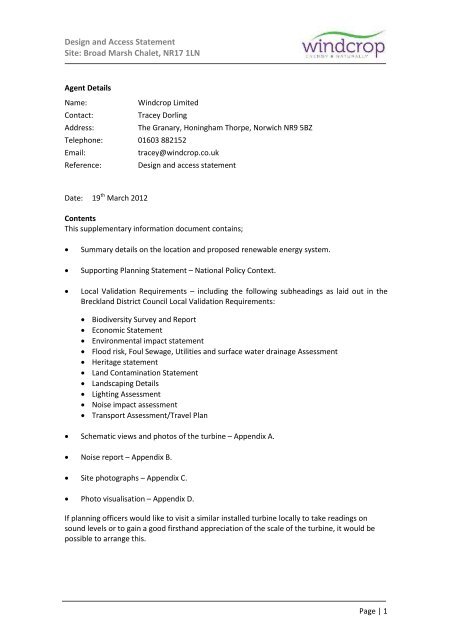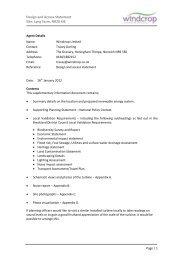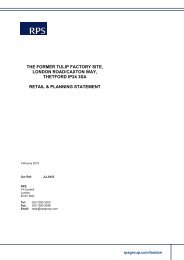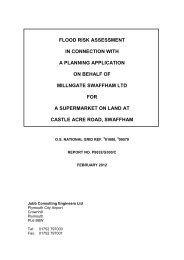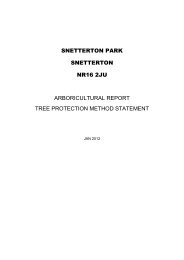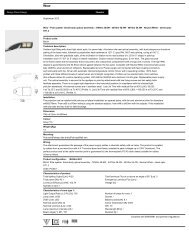Design and Access Statement Site: Broad Marsh Chalet, NR17 1LN
NR17%201LN%20Design%20and%20Access%20Statement.pdf
NR17%201LN%20Design%20and%20Access%20Statement.pdf
You also want an ePaper? Increase the reach of your titles
YUMPU automatically turns print PDFs into web optimized ePapers that Google loves.
<strong>Design</strong> <strong>and</strong> <strong>Access</strong> <strong>Statement</strong><br />
<strong>Site</strong>: <strong>Broad</strong> <strong>Marsh</strong> <strong>Chalet</strong>, <strong>NR17</strong> <strong>1LN</strong><br />
Agent Details<br />
Name:<br />
Windcrop Limited<br />
Contact:<br />
Tracey Dorling<br />
Address:<br />
The Granary, Honingham Thorpe, Norwich NR9 5BZ<br />
Telephone: 01603 882152<br />
Email:<br />
tracey@windcrop.co.uk<br />
Reference: <strong>Design</strong> <strong>and</strong> access statement<br />
Date: 19 th March 2012<br />
Contents<br />
This supplementary information document contains;<br />
<br />
<br />
<br />
Summary details on the location <strong>and</strong> proposed renewable energy system.<br />
Supporting Planning <strong>Statement</strong> – National Policy Context.<br />
Local Validation Requirements – including the following subheadings as laid out in the<br />
Breckl<strong>and</strong> District Council Local Validation Requirements:<br />
Biodiversity Survey <strong>and</strong> Report<br />
Economic <strong>Statement</strong><br />
Environmental impact statement<br />
Flood risk, Foul Sewage, Utilities <strong>and</strong> surface water drainage Assessment<br />
Heritage statement<br />
L<strong>and</strong> Contamination <strong>Statement</strong><br />
L<strong>and</strong>scaping Details<br />
Lighting Assessment<br />
Noise impact assessment<br />
Transport Assessment/Travel Plan<br />
Schematic views <strong>and</strong> photos of the turbine – Appendix A.<br />
Noise report – Appendix B.<br />
<strong>Site</strong> photographs – Appendix C.<br />
Photo visualisation – Appendix D.<br />
If planning officers would like to visit a similar installed turbine locally to take readings on<br />
sound levels or to gain a good firsth<strong>and</strong> appreciation of the scale of the turbine, it would be<br />
possible to arrange this.<br />
Page | 1
<strong>Design</strong> <strong>and</strong> <strong>Access</strong> <strong>Statement</strong><br />
<strong>Site</strong>: <strong>Broad</strong> <strong>Marsh</strong> <strong>Chalet</strong>, <strong>NR17</strong> <strong>1LN</strong><br />
Project Overview<br />
The project will provide <strong>Broad</strong> <strong>Marsh</strong> <strong>Chalet</strong> with a suitable method of generating a<br />
renewable, sustainable <strong>and</strong> efficient electrical energy supply using two Windcrop HY-5 small<br />
wind turbines. The turbines to be installed are economically viable, robust <strong>and</strong> quiet by design<br />
<strong>and</strong> extremely efficient. The turbines will be mounted two 15m towers <strong>and</strong> will be grid<br />
connected to a Single Phase supply.<br />
<strong>Site</strong> Description<br />
Installation location:<br />
<strong>Broad</strong>marsh Farm<br />
Long Street<br />
Great Ellingham<br />
Norfolk<br />
<strong>NR17</strong> <strong>1LN</strong><br />
OS grid reference: Turbine 1, X – 602262, Y – 296240<br />
Turbine 2, X – 602289, Y – 296248<br />
Estimated Annual Mean Wind Speed:<br />
Expected annual energy:<br />
Expected annual carbon saving:<br />
5.0 m/s<br />
9.02 MWh per Turbine<br />
4.84 tonnes per Turbine<br />
Nearest neighbour: 135m approximately from proposed location –<br />
‘Shelton Lodge’<br />
Nearest public road:<br />
Description:<br />
163m approximately from proposed location – Long<br />
Street<br />
Turbine 1 will be located on rough ground on the<br />
edge of agricultural l<strong>and</strong> to the north of the farm<br />
yard.<br />
Turbine 2 will be located approximately 20m to the<br />
east of turbine 1.<br />
The development comprises two small scale wind turbines. The proposed sites have been<br />
chosen to minimise any visual impact <strong>and</strong>/or noise disturbance. Crime prevention measures do<br />
not appear to be relevant to this development.<br />
The height of the tower has been selected to ensure that it is the required height to capture<br />
the wind energy on this site whilst keeping any impact to a minimum. The turbine has been<br />
designed for low noise operation <strong>and</strong> minimal visual impact.<br />
The tower is a matt grey colour galvanised to BSEN1461 while the turbine housing <strong>and</strong> blades<br />
have an anti-erosion coating in white. These characteristics will help it blend in with both the<br />
sky <strong>and</strong> the rural background at the location.<br />
Wind energy is an abundant natural resource. It is non-polluting, clean <strong>and</strong> sustainable. The UK<br />
has one of Europe‘s windiest climates <strong>and</strong> wind energy will be an important element in<br />
achieving the targets contained in the government’s UK Low Carbon Transition Plan published<br />
in Summer 2009. The overall target is to reduce carbon dioxide emissions to 34% below 1990<br />
Page | 2
<strong>Design</strong> <strong>and</strong> <strong>Access</strong> <strong>Statement</strong><br />
<strong>Site</strong>: <strong>Broad</strong> <strong>Marsh</strong> <strong>Chalet</strong>, <strong>NR17</strong> <strong>1LN</strong><br />
levels by 2020. More specifically, it is Government policy to achieve 30% of the nation’s<br />
electricity requirements from renewable sources by 2020.<br />
The Windcrop HY-5 wind turbine will be Micro generation Certification Scheme (MCS)<br />
approved. The turbine is CE marked <strong>and</strong> approved for sale in the UK.<br />
System Specification<br />
Wind turbine:<br />
Rated power:<br />
Hub height (ground to<br />
centre of hub):<br />
Rotor diameter:<br />
Tower type:<br />
Turbine finish:<br />
Blade finish:<br />
Tower finish:<br />
Rotor speed:<br />
Tip speed:<br />
Rotor orientation:<br />
Windcrop HY-5<br />
5kW @ 12m/s (26.0mph)<br />
14.97 m<br />
5.6 m<br />
Rotor swept area: 24.63 m 2<br />
Number of blades: 3<br />
Power regulation:<br />
Electrical connection:<br />
Tapered free st<strong>and</strong>ing tower (steel) & Helical Pile Foundation<br />
All exposed parts pot galvanised, painting in matt white<br />
Glass Fibre Reinforced Composite, anti-corrosion coating in matt<br />
white<br />
Matt grey galvanised to BSEN1461<br />
240 rpm nominal – maximum 280 rpm<br />
70.3m /sec nominal – maximum 82.1 m/sec<br />
Downwind, self-regulating<br />
Variable pitch system (mechanical) & G59 compliant inverter<br />
Single phase<br />
Page | 3
<strong>Design</strong> <strong>and</strong> <strong>Access</strong> <strong>Statement</strong><br />
<strong>Site</strong>: <strong>Broad</strong> <strong>Marsh</strong> <strong>Chalet</strong>, <strong>NR17</strong> <strong>1LN</strong><br />
Supporting Planning <strong>Statement</strong> – National Policy considerations.<br />
Wind energy is an abundant natural resource. It is non-polluting, clean <strong>and</strong> sustainable. The UK<br />
has one of Europe‘s windiest climates <strong>and</strong> wind energy is expected to be an important element<br />
in achieving the targets contained in the government’s UK Low Carbon Transition Plan<br />
published in Summer 2009. The overall target is to reduce carbon dioxide emissions to 34%<br />
below 1990 levels by 2020. In 2008 the UK agreed to achieve 15% of our national energy<br />
consumption from renewable energy by 2020, from a starting point of just 1.3% in 2005. More<br />
specifically, it is Government policy to achieve 30% of the nation’s electricity requirements<br />
from renewable sources by 2020. The Committee on Climate Change were asked by the new<br />
Coalition Government to review these targets <strong>and</strong> concluded in September 2010 that they<br />
should remain at their previously agreed levels.<br />
Planning Policy <strong>Statement</strong> 22 (PPS22), Renewable Energy (August 2004) <strong>and</strong> the accompanying<br />
Companion Guide, cover all aspects of renewable energy including considerations for the siting<br />
of wind turbines <strong>and</strong> encourages favourable views towards small scale renewable power<br />
sources. The PPS, Companion Guide <strong>and</strong> Technical Annex identify a number of specific issues<br />
that need to be considered when determining an application for planning permission:<br />
<br />
<br />
<br />
<br />
Noise: paragraph 41 of the Technical Annex states that noise levels from wind turbines<br />
are generally low <strong>and</strong>, under most operating conditions, it is likely that turbine noise<br />
would be completely masked by wind-generated background noise. The report, ‘The<br />
Assessment <strong>and</strong> rating of noise from Wind Farms (ETSU-R-97), describes a framework<br />
for the measurement of wind farm noise <strong>and</strong> gives indicative noise levels calculated to<br />
offer a reasonable degree of protection to wind farm neighbours, without placing<br />
unreasonable restrictions on wind farm development or adding unduly to the costs<br />
<strong>and</strong> administrative burdens on wind farm developers or planning authorities. The<br />
report can be regarded as relevant guidance on good practice. This methodology<br />
overcomes some of the disadvantages of BS4142 when assessing the noise effects of<br />
wind farms, <strong>and</strong> should be used by planning authorities when assessing <strong>and</strong> rating<br />
noise from wind energy developments (PSS22, paragraph 22).<br />
Visual <strong>and</strong> L<strong>and</strong>scape Impact: Of all renewable technologies, wind turbines are likely<br />
to have the greatest visual <strong>and</strong> l<strong>and</strong>scape effects. However, the impact of turbines on<br />
the l<strong>and</strong>scape will vary according to the size <strong>and</strong> number of turbines <strong>and</strong> the type of<br />
l<strong>and</strong>scape involved, <strong>and</strong> these impacts may be temporary if conditions are attached to<br />
planning permissions which require the future decommissioning of turbines.<br />
Safety: the Technical Annex identifies little or no risk arising to the public <strong>and</strong> states<br />
that properly designed <strong>and</strong> maintained generators are a safe technology.<br />
Ecology: PPS22 (paragraph 15) states that local nature conservation designations<br />
should not be used in themselves to refuse planning permissions for renewable energy<br />
developments. The Technical Annex states that the impact of a wind farm on local<br />
ecology should be minimal. A common concern has been the risk of bird strike; more<br />
recently, an additional concern around the risk of harm to bats has emerged.<br />
Electro-magnetic Production <strong>and</strong> Interference: the Technical Annex (paragraph 64)<br />
states that provided careful attention is paid to siting, wind turbines should not cause<br />
any significant problems of electrical interference. Scattering of signal is a<br />
Page | 4
<strong>Design</strong> <strong>and</strong> <strong>Access</strong> <strong>Statement</strong><br />
<strong>Site</strong>: <strong>Broad</strong> <strong>Marsh</strong> <strong>Chalet</strong>, <strong>NR17</strong> <strong>1LN</strong><br />
phenomenon that arises very occasionally <strong>and</strong> effects on radio or television<br />
transmitters can usually be resolved through careful siting, in consultation with the<br />
relevant bodies.<br />
<br />
<br />
<br />
Specialist Consultation: It may be necessary to consult specialist bodies, including<br />
users of telecommunications systems, local utility companies, or emergency services<br />
on occasions.<br />
Shadow Flicker: PPS22. Shadow flicker is a rare event which sometimes can occur<br />
when the shadow of the turbines blades play on nearby buildings at certain times of<br />
day <strong>and</strong> days of the year. It most commonly would affect nearby buildings to the East<br />
or West of the turbine at dusk <strong>and</strong> dawn. However this is not a problem normally<br />
found with small wind turbines <strong>and</strong> the siting of this installation eliminates any risk of<br />
shadow flicker on neighbouring buildings. Planning for Renewable Energy A<br />
Companion Guide to PPS22 advises that turbines should be positioned at least 10x the<br />
diameter of the rotor blades away from the nearest dwelling to prevent the possibility<br />
of shadow flicker.<br />
Icing: The Companion Guide states that the build-up of ice on turbine blades is unlikely<br />
to be a problem. For ice to build up on wind turbines particular weather conditions<br />
are required that in Engl<strong>and</strong> occur for less than one day per year<br />
Page | 5
<strong>Design</strong> <strong>and</strong> <strong>Access</strong> <strong>Statement</strong><br />
<strong>Site</strong>: <strong>Broad</strong> <strong>Marsh</strong> <strong>Chalet</strong>, <strong>NR17</strong> <strong>1LN</strong><br />
Siting <strong>and</strong> scale<br />
It has been normal practice to site utility scale wind turbines on elevated <strong>and</strong> exposed ground<br />
in order to achieve the highest possible energy capture <strong>and</strong> optimise the economics of the<br />
project. This has led to considerable opposition to wind power projects wherever they have<br />
been proposed. It is important to appreciate that the proposed turbine is of a completely<br />
different scale to the now familiar utility scale giants, which may have tower heights of 100m<br />
<strong>and</strong> rotor diameters of 80m or more.<br />
By way of comparison, the proposed installation sits on a 15 metre mast with a rotor diameter<br />
of 5.5 metres <strong>and</strong> is closer in scale to a typical telegraph or power transmission pole, which<br />
forms a familiar aspect of our rural l<strong>and</strong>scape. The diagram below demonstrates this contrast.<br />
120m<br />
110m<br />
100m<br />
90m<br />
80m<br />
70m<br />
60m<br />
50m<br />
40m<br />
30m<br />
20m<br />
10m<br />
Typical Wind Farm Turbine<br />
compared with proposed 5kW turbine<br />
Rotor Dia (m) 82 5.4<br />
Hub Height (m) 78 15<br />
Power(kW): 1,650 5<br />
Output(MWh/yr)4,300 7.4<br />
CO2(t/yr) 1,900 4.0<br />
Eq households 970 1.7<br />
Views on Small Wind Turbines<br />
<br />
The Royal Society for the Protection of Birds (RSPB):<br />
The RSPB has in the past been a strong opponent of many large wind farms, however they<br />
have recently expressed their support for renewable energy, including wind farms <strong>and</strong> locally<br />
generated energy.<br />
“We particularly support solutions that enable individuals <strong>and</strong> communities to generate their<br />
own power close to their homes <strong>and</strong> businesses.<br />
Page | 6
<strong>Design</strong> <strong>and</strong> <strong>Access</strong> <strong>Statement</strong><br />
<strong>Site</strong>: <strong>Broad</strong> <strong>Marsh</strong> <strong>Chalet</strong>, <strong>NR17</strong> <strong>1LN</strong><br />
Wind power is the most advanced renewable technology available at a large scale during this<br />
time period. For this reason, the RSPB supports a significant growth in offshore <strong>and</strong> onshore<br />
wind power generation in the UK.<br />
We believe that this growth can be achieved in harmony with, rather than at the expense of,<br />
the natural environment. We will therefore continue to require that wind farms are sited,<br />
designed <strong>and</strong> managed so that there are no significant adverse impacts on important bird<br />
populations or their habitats.”<br />
http://www.rspb.org.uk/ourwork/policy/windfarms/index.asp<br />
<br />
The National Trust:<br />
"We are committed to investing in small-scale renewables, greater energy efficiency, <strong>and</strong> using<br />
low carbon materials <strong>and</strong> products to reduce our use of fossil fuels."<br />
“From our practical experience, we believe that small-scale renewable energy has huge<br />
potential to be a cost effective <strong>and</strong> sustainable means of providing affordable heat <strong>and</strong><br />
electricity to homes <strong>and</strong> businesses.”<br />
http://209.85.229.132/u/nationaltrust?q=cache:CDXpfDxCiYwJ:www.nationaltrust.org.uk/mai<br />
n/w-microgen-policy_from_practice.pdf+microgen&cd=1&hl=en&ct=clnk&ie=UTF-8<br />
<br />
English Nature:<br />
English Nature’s response to renewable energy: "We welcome the scaling up of wind energy<br />
both onshore <strong>and</strong> offshore, <strong>and</strong> want to work with government <strong>and</strong> industry to find the right<br />
places for new wind energy development.<br />
We believe that the target will need to be delivered at all scales. Small scale community energy<br />
production has an important role to play in making rapid progress toward the UK renewables<br />
target while larger scale projects, with a much longer lead-in time, are developed."<br />
http://www.naturalengl<strong>and</strong>.org.uk/about_us/news/2008/260608.aspx<br />
Page | 7
<strong>Design</strong> <strong>and</strong> <strong>Access</strong> <strong>Statement</strong><br />
<strong>Site</strong>: <strong>Broad</strong> <strong>Marsh</strong> <strong>Chalet</strong>, <strong>NR17</strong> <strong>1LN</strong><br />
Local Validation Requirements<br />
In preparing this section of the documentation, the Breckl<strong>and</strong> District Council Local Validation<br />
Requirements have been reviewed <strong>and</strong> information is provided in all relevant categories.<br />
Economic <strong>Statement</strong>:<br />
Each wind turbine is expected to generate an average of 9.02 MWh of electricity each year,<br />
equivalent to a saving of 4.84 tonnes of carbon dioxide. This yield data has been calculated<br />
from the Small Wind Turbine Yield Calculator, jointly developed by the Carbon Trust <strong>and</strong><br />
Renewable UK (formerly BWEA) <strong>and</strong> which is widely recognised as the most accurate yield<br />
forecast tool available. In particular it has addressed many of the issues of overoptimistic yield<br />
forecasts from earlier tools which did not take account of local geographic conditions.<br />
This installed capacity will also help to contribute towards regional targets for renewable<br />
energy generation included in the UK Low Carbon Transition Plan.<br />
Biodiversity:<br />
A site check has been made using the Multi Agency Geographic Information for the<br />
Countryside Interactive Map (MAGIC), managed by Natural Engl<strong>and</strong> on behalf of DEFRA. The<br />
site is not situated in a protected habitat area, nor is it located close to one. We conclude that<br />
the proposed development does not present a risk to protected sites or their designated<br />
features.<br />
In addition, the proposed site has been assessed in accordance with guidelines for the siting of<br />
small wind turbines, prepared by an established independent ecological consultant, so as to<br />
minimise risks to protected species. The site assessment considers features which may be<br />
used by bats or birds, <strong>and</strong> takes account of the available guidance in relation to the siting of<br />
small wind turbines. These features comprise trees, hedgerows, ponds <strong>and</strong> waterways,<br />
including permanently wet ditches. A micro turbine on or close to any hedgerow or linear<br />
feature may increase the likelihood of an effect on bat populations. The relationship to<br />
connective habitat is also taken into consideration, as many species of bats follow linear<br />
features when travelling between foraging sites <strong>and</strong> a roost. Isolated or fragmented habitat<br />
features are less likely to be used by bats as they provide little cover or foraging potential.<br />
Particular attention has been paid to ensuring that the site is an appropriate distance from<br />
potential bat habitats <strong>and</strong> roost sites. Bats roost in a wide range of buildings <strong>and</strong> all buildings<br />
except those constructed from non-traditional, modern or pre-fabricated materials, are<br />
considered as potential bat roosts. Large mature trees (girth greater than 300cm) are also<br />
potentially suitable as roost sites.<br />
There are no known bat roosts or buildings that could potentially become bat roosts within<br />
50m of the site, <strong>and</strong> the closest potential foraging feature is located over 25m from the<br />
turbine. No trees, hedgerows or scrub will be affected by the installation <strong>and</strong> the turbine is<br />
not expected to disturb any ground dwelling fauna. Hence the risk of harm to protected<br />
species is considered minimal.<br />
L<strong>and</strong>scape <strong>and</strong> visual impact:<br />
The site is not situated in an Area of Outst<strong>and</strong>ing Natural Beauty. Care has been taken to<br />
minimise the l<strong>and</strong>scape <strong>and</strong> visual impact, <strong>and</strong> views from adjacent receptors have been<br />
considered. No significant l<strong>and</strong>scape or visual impact issues have been identified. Images of<br />
Page | 8
<strong>Design</strong> <strong>and</strong> <strong>Access</strong> <strong>Statement</strong><br />
<strong>Site</strong>: <strong>Broad</strong> <strong>Marsh</strong> <strong>Chalet</strong>, <strong>NR17</strong> <strong>1LN</strong><br />
the site <strong>and</strong> surrounding area are provided at Appendix C <strong>and</strong> a visualisation of the turbine<br />
viewed from approximately 100 m is provided at Appendix D.<br />
We conclude that the small scale of the development will not have an unacceptable impact on<br />
l<strong>and</strong>scape or visual amenity.<br />
Heritage <strong>Statement</strong>:<br />
A site check has been made using the MAGIC interactive map to identify any relevant<br />
archaeological sites, scheduled ancient monuments, conservation areas <strong>and</strong> historic parks <strong>and</strong><br />
gardens, a copy of which is enclosed. None were identified within 1.5km of the site. The<br />
proposed location is not in the vicinity of any known Conservation Areas.<br />
A listed building search has been conducted using the online search engine maintained by<br />
English Heritage, with the following results;<br />
The search identified sixteen listed buildings within a 1Km radius of the proposed installation.<br />
1. Church of St James (LB) is situated approximately 942 metres to the north northwest<br />
of the proposed development with various fields, hedging, trees of various sizes <strong>and</strong><br />
existing buildings in the intervening area between the two locations. A description of<br />
the church is provided below;<br />
TM 09 NW GREAT ELLINGHAM CHURCH STREET<br />
5/21 Church of St. James 16/ 7/58 - G I<br />
Page | 9
<strong>Design</strong> <strong>and</strong> <strong>Access</strong> <strong>Statement</strong><br />
<strong>Site</strong>: <strong>Broad</strong> <strong>Marsh</strong> <strong>Chalet</strong>, <strong>NR17</strong> <strong>1LN</strong><br />
Parish church. Mainly early C14, restored 1900-20. Flint with ashlar dressings <strong>and</strong> gabled lead<br />
roof. West tower, nave, aisles <strong>and</strong> continuous chancel. 3 stage tower with diagonal buttresses<br />
to west, angle to east.Chequered flushwork base <strong>and</strong> west door of double quadrant mouldings,<br />
3-light Perpendicular west window with transom <strong>and</strong> hood mould. 2-light Y belfrey windows<br />
cinquefoiled. Chequered flushwork battlemented parapet above string course. Short octagonal<br />
leaded needle spire. Diagonal buttresses to north aisle. 2-light west window of divergent<br />
mouchettes <strong>and</strong> segmental window arch. North porch with 4-centred arch below statue niche,<br />
both with hoods. Inner wall arch to west <strong>and</strong> 2-light cusped window. Inner door with undercut<br />
hollow <strong>and</strong> wave mouldings. Butt purlin roof. Remainder of aisle windows as west except last<br />
bay (the Mortimer chapel) : north window C2O, 3 lights; east window 3-light cusped<br />
intersecting ogees. Blocked 4-centred door with fleurons. String course of chapel continuous<br />
with chancel. 3 tall 2-light chancel windows with cinquefoil arches supporting double<br />
reticulation within larger unit. Hood moulds form continuous string course. Eastern angle<br />
buttresses. East wall chequered flushwork. 5-light east window divided 2-1-2 with heavily<br />
cusped arches supporting elementary petal motif below encircled quatrefoil vesica. 2 3-light<br />
chancel south windows with convergent mouchettes <strong>and</strong> hoods forming string course. Arched<br />
priest's door between. South aisle east window as Mortimer chapel. 3 stepped buttresses <strong>and</strong><br />
early C20 2 <strong>and</strong> 3-light windows. Arched south door. Clerestory walls of knapped chequered<br />
flushwork containing 5 2-light windows on both sides, those to west halved by tower. Interior 4<br />
bay arcade, quatrefoil between fillets on south with moulded bases <strong>and</strong> capitals, similar but<br />
with sunk quadrant to north <strong>and</strong> polygonal capitals. Double sunk quadrant arches, including<br />
tower arch. Clerestory windows behind deep reveals above piers. Nave roof of tie beams on<br />
arched braces dropping to head corbels with traceried sp<strong>and</strong>rels. Short King posts <strong>and</strong> braces<br />
to ridge piece. Wall plate with boxed ashlaring. Renewed principals. C18 chancel rooLof, thin,<br />
false hammerbeams. Aisle roofs from restoration. Early C18 gallery at west supported on pair<br />
of timber Doric pilasters below metoped frieze. Gate with H hinges. Second stage forms ringing<br />
chamber. Mid C14 octagonal font with Kentish tracery panels <strong>and</strong> shields <strong>and</strong> fleurons below<br />
bowl. Part of C15 painted screen with elaborate traceried fields above dado of foliated<br />
encircled trefoils. Rood loft stairs blocked on north side. 2 painted consecration crosses on<br />
south wail <strong>and</strong> remains of wall painting of Pilgrims approaching shrine. Wide sculptural niche<br />
under tripartite nodding ogee vault, cusped with crockets <strong>and</strong> finials. Remains of painting<br />
including good torso of Angel, probably late C14. Remains of parclose screen to south- east<br />
chapel with petal tracery of same date. Chapel has piscina under foliated cinquefoil head <strong>and</strong><br />
bench sedilia. Jambs remain of chancel sedilia.<br />
Page | 10
<strong>Design</strong> <strong>and</strong> <strong>Access</strong> <strong>Statement</strong><br />
<strong>Site</strong>: <strong>Broad</strong> <strong>Marsh</strong> <strong>Chalet</strong>, <strong>NR17</strong> <strong>1LN</strong><br />
2. The Old Queens Head (LB) is located approximately 558 metres to the north east of<br />
then proposed development with various fields, existing buildings, hedging <strong>and</strong> trees<br />
of various sizes in the intervening area between the two sites.<br />
3. Baptist Chapel (LB) is situated approximately 451 metres to the north west of the<br />
proposed development with various fields, existing buildings, hedging <strong>and</strong> trees of<br />
various sizes in the intervening area between the two sites.<br />
4. Barn 150 yards south east of Old Hall Farmhouse (LB) is located approximately 594<br />
metres to the north west of the proposed development with various fields, existing<br />
buildings, hedging, trees of various sizes <strong>and</strong> Long Street in the intervening area<br />
between the two sites.<br />
5. Old Hall Farmhouse (LB) is situated approximately 719 metres to the north west of the<br />
proposed develpoment with various fields, existing buildings, hedging, trees of various<br />
sizes <strong>and</strong> Long Street in the intervening area between the two sites.<br />
6. Barn 30 yards north west of Old Hall Farmhouse (LB) is situated approximately 745<br />
metres to the north west of the proposed develpoment with various fields, existing<br />
buildings, hedging, trees of various sizes <strong>and</strong> Long Street in the intervening area<br />
between the two sites.<br />
7. Poplar Farmhouse (LB) is located approximately 508 metres to the north west of the<br />
proposed development with with various fields, existing buildings, hedging <strong>and</strong> trees<br />
of various sizes in the intervening area between the two sites.<br />
8. Grey Roofs (LB) is located approximately 756 metres to the north west of the proposed<br />
development with with various fields, existing buildings, hedging <strong>and</strong> trees of various<br />
sizes in the intervening area between the two sites.<br />
9. Row of thatched cottages to north side of green (LB) is situated approximately 888<br />
metres to the north west of the proposed development with with various fields,<br />
Page | 11
<strong>Design</strong> <strong>and</strong> <strong>Access</strong> <strong>Statement</strong><br />
<strong>Site</strong>: <strong>Broad</strong> <strong>Marsh</strong> <strong>Chalet</strong>, <strong>NR17</strong> <strong>1LN</strong><br />
existing buildings, hedging, trees of various sizes, Long Street <strong>and</strong> Town Green in the<br />
intervening area between the two sites.<br />
10. Windmill (LB) is located approximately 779 metres to the north west of the proposed<br />
development with with various fields, existing buildings, hedging <strong>and</strong> trees of various<br />
sizes in the intervening area between the two sites.<br />
11. Mill Farmhouse (LB) is located approximately 815 metres to the north west of the<br />
proposed development with with various fields, existing buildings, hedging <strong>and</strong> trees<br />
of various sizes in the intervening area between the two sites.<br />
12. 1 – 5 Church Street (LB) are situated approximately 847 metres to the north west of<br />
the proposed development with various fields, existing buildings, hedging, trees of<br />
various sizes <strong>and</strong> Church Street in the intervening area between the two sites.<br />
13. 9, 11 & 13 Church Street (LB) are situated approximately 861 metres to the north west<br />
of the proposed development with various fields, existing buildings, hedging, trees of<br />
various sizes <strong>and</strong> Church Street in the intervening area between the two sites.<br />
14. The Olde Thatche Shoppe (LB) is located approximately 876 metres to the north<br />
nortghwest of the proposed development with various fields, existing buildings,<br />
hedging <strong>and</strong> trees of various sizes in the intervening area between the two sites.<br />
15. Islay House (LB) is located approximately 905 metres to the north nortghwest of the<br />
proposed development with various fields, existing buildings, hedging <strong>and</strong> trees of<br />
various sizes in the intervening area between the two sites.<br />
16. Glenfield Cottage (LB) is situated approximately 986 metres to the north northwest of<br />
the proposed development with with various fields, existing buildings, hedging <strong>and</strong><br />
trees of various sizes in the intervening area between the two sites.<br />
We conclude that the small scale of the development will not cause any adverse effect on the<br />
above listings.<br />
Noise Impact Assessment:<br />
The turbine manufacturer has commissioned an independent noise report as part of the<br />
accreditation procedures required to enable the equipment to qualify for the Feed-In Tariff<br />
(FiT) scheme introduced on 1 April 2010. Appendix B details the noise impact assessment. The<br />
distance to the garden boundary of the nearest neighbour is approximately 113 metres to the<br />
west southwest of the installation. Existing agricultural buildings, trees of various sizes <strong>and</strong><br />
hedging are situated between the turbines location <strong>and</strong> the neighbour <strong>and</strong> leads us to<br />
conclude that the neighbouring property will not be adversely affected.<br />
Below Ground Environmental Impact:<br />
A helical pile foundation system is used in place of traditional concrete foundations. The mast<br />
is mounted on a tripod which is located by three helical piles. These are inserted by rotation<br />
<strong>and</strong> are normally drilled to a depth of 3-4m. Each ‘foot’ rests on a pad, excavated to a depth of<br />
approximately 250mm <strong>and</strong> measuring approximately 600 x 500 mm. The piles are<br />
approximately 3m apart <strong>and</strong> can be removed by the same method, leaving no residual<br />
structure. Helical piles do minimal damage to the ground <strong>and</strong> any (under)ground dwelling<br />
animals, as well as being easily retracted on decommissioning of the turbine.<br />
The connection cable is buried 600mm deep in a 150-175mm wide trench (x cable length). A<br />
Ditchwitch ‘pedestrian trencher’ RT24 is used to cut <strong>and</strong> backfill the trench. The trenching is<br />
completed as a single operation, taking no more than a day. Disturbance to ground vegetation<br />
is therefore minimal <strong>and</strong> temporary in nature. As a result, restoration of the site following decommissioning<br />
is very low impact <strong>and</strong> existing flora in the area adjoining the site will be<br />
retained.<br />
Page | 12
<strong>Design</strong> <strong>and</strong> <strong>Access</strong> <strong>Statement</strong><br />
<strong>Site</strong>: <strong>Broad</strong> <strong>Marsh</strong> <strong>Chalet</strong>, <strong>NR17</strong> <strong>1LN</strong><br />
No ancillary structures or buildings are required to house electrical equipment or controllers,<br />
which will be mounted to the mast base. The cable to feed the generated power to the nearest<br />
building will be buried in accordance with BS7671:2008.<br />
Shadow Flicker:<br />
The nearest dwelling is approximately 135 metres from the proposed installation, which is<br />
outside the recommended calculation of 55 metres for the selected turbine.<br />
Flood Risk Assessment, Foul Sewage <strong>and</strong> Utilities Assessment, Surface Water Drainage:<br />
Considering each of these <strong>and</strong> the nature of the proposal, it is concluded that these are not<br />
applicable to the project because the turbine will not create or use any extra water. No sewage<br />
will be generated from the site <strong>and</strong> surface water drainage will be unaffected.<br />
L<strong>and</strong> Contamination <strong>Statement</strong>:<br />
The proposed site is two small areas of rough ground on the northern periphery of the farm<br />
yard <strong>and</strong> is not known to be contaminated. The installation will not result in contamination<br />
<strong>and</strong> on decommissioning the helical piles will simply be unscrewed leaving no residual<br />
material.<br />
Lighting Assessment:<br />
No external lighting is to be installed on or around the turbine.<br />
Parking Provision:<br />
No dedicated parking or other access provision will be required for the turbine.<br />
Photographs:<br />
Please see appendix C.<br />
Transport Assessment/Travel plan:<br />
The installation process will generate minimal traffic, involving one day on site to insert the<br />
foundation helical piles <strong>and</strong> erect the turbine.<br />
Following installation, access will be required for routine maintenance only. <strong>Access</strong> will be via<br />
the existing entrance to the farm yard, which would also provide good access for any<br />
emergency services in the unlikely event they were required.<br />
The remaining items which appear on the local list have been considered <strong>and</strong> determined to<br />
be not relevant to this application.<br />
Page | 13
<strong>Design</strong> <strong>and</strong> <strong>Access</strong> <strong>Statement</strong><br />
<strong>Site</strong>: <strong>Broad</strong> <strong>Marsh</strong> <strong>Chalet</strong>, <strong>NR17</strong> <strong>1LN</strong><br />
Appendix A - Schematics<br />
The diagrams below are representative of the system proposed to be installed.<br />
The 15m tower is supported by a patented tripod system which is located on three helical<br />
piles, each of 4m depth. This type of foundation system has the advantage of being more<br />
environmentally sensitive than a large concrete block <strong>and</strong> easier to remove to reinstate the<br />
site in future.<br />
Windcrop is a Micro generation Certified Scheme (MCS) accredited installer <strong>and</strong> an ISO9001<br />
certified organisation - the works will be completed by our own installation.<br />
Page | 14
<strong>Design</strong> <strong>and</strong> <strong>Access</strong> <strong>Statement</strong><br />
<strong>Site</strong>: <strong>Broad</strong> <strong>Marsh</strong> <strong>Chalet</strong>, <strong>NR17</strong> <strong>1LN</strong><br />
Side View of Windcrop HY-5<br />
Front view of Windcrop HY-5<br />
Page | 15
<strong>Design</strong> <strong>and</strong> <strong>Access</strong> <strong>Statement</strong><br />
<strong>Site</strong>: <strong>Broad</strong> <strong>Marsh</strong> <strong>Chalet</strong>, <strong>NR17</strong> <strong>1LN</strong><br />
Appendix B - Noise Report: Windcrop HY-5<br />
Acoustic Impact Assessment of Small Wind System Installation<br />
Introduction<br />
The Windcrop HY-5 is designed to minimise noise generation. Wind generator noise issues in<br />
the past have chiefly arisen from either mechanical gearbox noise or aerodynamic noise.<br />
The Windcrop HY-5 generator is a direct drive system <strong>and</strong> has no significant sources of<br />
mechanical noise.<br />
The Windcrop HY-5 generator blades are specifically designed to minimise aerodynamic noise.<br />
To achieve this, the rotor is designed to operate at unusually low speed, with a nominal blade<br />
tip speed of 70.3m/s. The blades vary in twist <strong>and</strong> chord along their length to maximise<br />
efficiency <strong>and</strong> thus minimise noise. In particular, the blade chord has been kept as small as is<br />
practicable near the tip. Also the blade tips themselves are carefully shaped specifically to<br />
minimise noise.<br />
Measured Noise Levels<br />
The Windcrop HY-5 is currently undergoing noise testing as part of the overall testing<br />
requirement for its accreditation under the Micro generation Certification Scheme (MCS). The<br />
relevant testing st<strong>and</strong>ard is MCS006 - Micro <strong>and</strong> Small Wind Turbines, which references the<br />
BWEA Small Wind Generator Performance <strong>and</strong> Safety St<strong>and</strong>ard (29 February 2008). Noise<br />
testing <strong>and</strong> assessment procedures <strong>and</strong> criteria are detailed in Section 3: Acoustic Sound<br />
Testing <strong>and</strong> Appendix A: Notes on the Use of Noise Label Information.<br />
The provisional BWEA Reference Sound Levels at 25m <strong>and</strong> 60m at an 8m/s hub height wind<br />
speed are:<br />
Lp, 25m = 52.5dB(A)<br />
Lp, 60m = 45dB(A)<br />
The location of the property <strong>and</strong> the generator is such that the nearest neighbour is in excess<br />
of 135m distant. It is anticipated that the generator’s noise performance will satisfy the<br />
st<strong>and</strong>ards <strong>and</strong> will not impact neighbouring properties. Testing on a comparable installation,<br />
mounted on a 15m pole achieved a noise immission of below 45dB(A) at any point greater<br />
than 50m from the installation at wind speeds up to 8m/s or Force 5. Above these wind<br />
speeds, the noise from the surrounding trees <strong>and</strong> buildings would be much greater than that<br />
from the generator.<br />
Recommended Good Practice on Controlling Noise from Wind Turbines<br />
From ‘The Assessment <strong>and</strong> Rating of Noise from Wind Farms’ (ETSU-R-97).<br />
The current practice on controlling wind farm noise by the application of noise limits at the<br />
nearest noise-sensitive properties is the most appropriate approach.<br />
Noise limits should be applied to external locations <strong>and</strong> should apply only to those areas<br />
frequently used for relaxation or activities for which a quiet environment is highly desirable.<br />
Page | 16
<strong>Design</strong> <strong>and</strong> <strong>Access</strong> <strong>Statement</strong><br />
<strong>Site</strong>: <strong>Broad</strong> <strong>Marsh</strong> <strong>Chalet</strong>, <strong>NR17</strong> <strong>1LN</strong><br />
Noise limits set relative to the background noise are more appropriate in the majority of cases.<br />
Generally, the noise limits should be set relative to the existing background noise at the<br />
nearest noise-sensitive properties <strong>and</strong> the limits should reflect the variation in both turbine<br />
source noise <strong>and</strong> background noise with wind speed.<br />
It is not necessary to use a margin above background noise levels in particularly quiet areas.<br />
This would unduly restrict developments that are recognised as having wider national <strong>and</strong><br />
global benefits. Such low limits are, in any event, not necessary in order to offer a reasonable<br />
degree of protection to wind farm neighbours.<br />
Separate noise limits should apply for day-time <strong>and</strong> for night-time as during the night the<br />
protection of external amenity becomes less important <strong>and</strong> the emphasis should be on<br />
preventing sleep disturbance.<br />
Absolute noise limits <strong>and</strong> margins above background should relate to the cumulative effect of<br />
all wind turbines in the area contributing to the noise received at the properties in question.<br />
Any existing turbines should not be considered as part of the prevailing background noise.<br />
Noise from the wind farm should be limited to 5 dB(A) above background for both day- <strong>and</strong><br />
night-time, remembering that the background level of each period may be different.<br />
The L A90,10min descriptor should be used for both the background noise <strong>and</strong> the wind farm noise,<br />
<strong>and</strong> when setting limits it should be borne in mind that the L A90,10min of the wind farm is likely to<br />
be about 1.5-2.5 dB(A) less than the L Aeq measured over the same period. The use of the<br />
L A90,10min descriptor for wind farm noise allows reliable measurements to be made without<br />
corruption from relatively loud, transitory noise events from other sources.<br />
A fixed limit of 43 dB(A) is recommended for night-time. This is based on a sleep disturbance<br />
criteria of 35 dB(A) with an allowance of 10 dB(A) for attenuation through an open window<br />
(free field to internal) <strong>and</strong> 2 dB(A) subtracted to account for the use of L A90,10min rather than<br />
L Aeq,10min .<br />
Both day- <strong>and</strong> night-time lower fixed limits can be increased to 45 dB(A) to increase the<br />
permissible margin above background where the occupier of the property has some financial<br />
interest in the wind farm.<br />
In low noise environments the day-time level of the L A90,10min of the wind farm noise should be<br />
limited to an absolute level within the range of 35-40 dB(A). The actual value chosen within<br />
this range should depend upon: the number of dwellings in the neighbourhood of the wind<br />
farm, the effect of noise limits on the number of kWh generated, <strong>and</strong> the duration of the level<br />
of exposure.<br />
For single turbines or wind farms with very large separation distances between the turbines<br />
<strong>and</strong> the nearest properties, a simplified noise condition may be suitable. If the noise is limited<br />
to a L A90,10min of 35 dB(A) up to wind speeds of 10 m/s at 10 m height, then this condition alone<br />
would offer sufficient protection of amenity, <strong>and</strong> background noise surveys would be<br />
unnecessary.<br />
Page | 17
<strong>Design</strong> <strong>and</strong> <strong>Access</strong> <strong>Statement</strong><br />
<strong>Site</strong>: <strong>Broad</strong> <strong>Marsh</strong> <strong>Chalet</strong>, <strong>NR17</strong> <strong>1LN</strong><br />
Appendix C - <strong>Site</strong> photographs<br />
View north from turbine 1.<br />
View east from turbine 1.<br />
Page | 18
<strong>Design</strong> <strong>and</strong> <strong>Access</strong> <strong>Statement</strong><br />
<strong>Site</strong>: <strong>Broad</strong> <strong>Marsh</strong> <strong>Chalet</strong>, <strong>NR17</strong> <strong>1LN</strong><br />
View south from turbine 1.<br />
View west from turbine 1.<br />
Page | 19
<strong>Design</strong> <strong>and</strong> <strong>Access</strong> <strong>Statement</strong><br />
<strong>Site</strong>: <strong>Broad</strong> <strong>Marsh</strong> <strong>Chalet</strong>, <strong>NR17</strong> <strong>1LN</strong><br />
Panoramic view north east south from turbine 1.<br />
Panoramic view south west north from turbine 1.<br />
Page | 20
<strong>Design</strong> <strong>and</strong> <strong>Access</strong> <strong>Statement</strong><br />
<strong>Site</strong>: <strong>Broad</strong> <strong>Marsh</strong> <strong>Chalet</strong>, <strong>NR17</strong> <strong>1LN</strong><br />
View north from turbine 2.<br />
View east from turbine 2.<br />
Page | 21
<strong>Design</strong> <strong>and</strong> <strong>Access</strong> <strong>Statement</strong><br />
<strong>Site</strong>: <strong>Broad</strong> <strong>Marsh</strong> <strong>Chalet</strong>, <strong>NR17</strong> <strong>1LN</strong><br />
View south from turbine 2.<br />
View west from turbine 2.<br />
Page | 22
<strong>Design</strong> <strong>and</strong> <strong>Access</strong> <strong>Statement</strong><br />
<strong>Site</strong>: <strong>Broad</strong> <strong>Marsh</strong> <strong>Chalet</strong>, <strong>NR17</strong> <strong>1LN</strong><br />
Panoramic view north east south from turbine 2.<br />
Panoramic view south west north from turbine 2.<br />
Viewpoints<br />
Page | 23
<strong>Design</strong> <strong>and</strong> <strong>Access</strong> <strong>Statement</strong><br />
<strong>Site</strong>: <strong>Broad</strong> <strong>Marsh</strong> <strong>Chalet</strong>, <strong>NR17</strong> <strong>1LN</strong><br />
Viewpoint 1 from the farm yard to the east looking west.<br />
Viewpoint 2 from the farm yard to the northeast looking southwest.<br />
Page | 24
<strong>Design</strong> <strong>and</strong> <strong>Access</strong> <strong>Statement</strong><br />
<strong>Site</strong>: <strong>Broad</strong> <strong>Marsh</strong> <strong>Chalet</strong>, <strong>NR17</strong> <strong>1LN</strong><br />
Viewpoint 3 from Long Street to the south southwest looking north northeast.<br />
Viewpoint 4 from Long Street at the site entrance to the west southwest looking east<br />
northeast.<br />
Page | 25
<strong>Design</strong> <strong>and</strong> <strong>Access</strong> <strong>Statement</strong><br />
<strong>Site</strong>: <strong>Broad</strong> <strong>Marsh</strong> <strong>Chalet</strong>, <strong>NR17</strong> <strong>1LN</strong><br />
Viewpoint 5 from foot path to the northwest looking southeast.<br />
Page | 26
<strong>Design</strong> <strong>and</strong> <strong>Access</strong> <strong>Statement</strong><br />
<strong>Site</strong>: <strong>Broad</strong> <strong>Marsh</strong> <strong>Chalet</strong>, <strong>NR17</strong> <strong>1LN</strong><br />
Appendix D – Visualisation<br />
Viewpoint<br />
Page | 27


